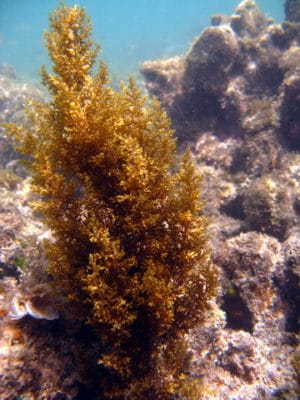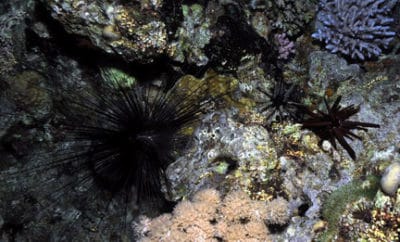Most of us have read about the coral reef crisis and have heard about the factors that have contributed to the degradation of reefs – most often overfishing, pollution, sedimentation have been cited as the causes, and more recently climate change. There is good evidence, at least on a local scale in areas close to large human populations, that excessive of these types of anthropogenic impacts are the root cause of the death of the reef. There is a lot of disagreement, though, on the specific factors and it is often hard to attribute the cause to one broad scale (general) impact like overfishing.
For instance, many Caribbean reefs have undergone what is often referred to as a phase shift, which is a shift from highly productive coral dominated systems to hardground areas inundated with fleshy macroalgae like Lopophora, Dictyota, Turbinaria and other types of seaweed.
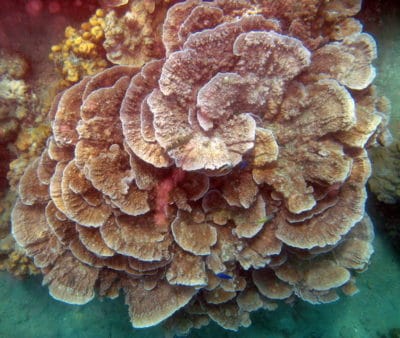
Foliose Montipora colony in turbid water.
In some locations, this has been attributed to a mass die-off of a critical herbivore, the long spined black sea urchin also known as Diadema. This is evident in locations that were overfished prior to the die-off, especially when few key herbivorous fish (fish that eat algae and plants), such as the surgeonfish and parrotfish, remained.
There is also another camp that links the phase shift to increased eutrophication due to runoff, discharge of sewage, and so on. Whatever the cause, we know that corals grow pretty slowly and algae grows much faster. Many types of macroalgae can shade and overgrow corals and they also monopolize the bottom, eliminating places for the successful settlement and survival of coral larvae.
Recognizing the dire state of many reefs, and increasing concerns of climate change, such as some of the recent and particularly devastating bleaching events (1998, 2005) that have resulted in wholesale death of corals, there is a new call for action to protect these precious resources and make them better able to cope under some particularly morose future scenarios of climate change.
This new direction includes identification of factors and processes that may enhance the “resilience” of reefs (e.g. the ability for a reef to absorb or recover from disturbance while maintaining its functions and services) and we also seeks to identify those reefs that exhibit a high degree of resilience for targeted conservation action. Yet, this may be a bit more complicated to achieve than simple solutions summarized in many recent resilience monitoring and management documents.
While it is critical to understand the threats affecting the system, and properly address those threats, what makes a reef resilient is not necessarily as intuitive. For instance, we’ve all been told that dense cover of algae may prevent successful recruitment and survival of coral spat. Sounds logical, except this doesn’t necessarily always seem to be the case on the reefs we’ve visited. Take a close look at the photograph; the substrate does not seem to be ideal, yet there are seemingly healthy juvenile corals. In fact, on some areas we looked at that have similar “poor” substrate quality we’ve seen recruitment levels that are off the scale; 100s of juvenile corals per square meter.
There’s also a lot of talk about the importance of parrotfish and other herbivorous fish. While these are critical components of a healthy reef, it’s important to remember that a parrotfish is not just any old herbivore.
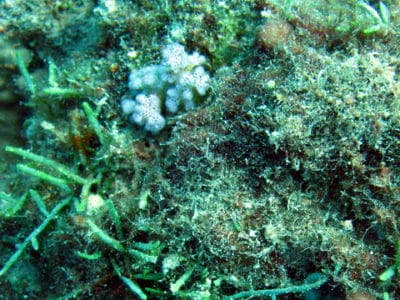
Juvenile Pocillopora in a thick bed of macroalgae.
Some are browsers, delicately plucking at fine filamentous algae, while others are excavators that bite off chunks of the reef as they feed on algae. There are also many kinds of algae, and these herbivores all have different feeding preferences.
However, the fish aren’t the only vegetarians on the reef. On our night dive, this became apparent. Echinoderms emerged from their daytime refuge. Not only did we see Diadema, but we saw many pencil urchins and other species of sea urchins, as well. All of these grazers are key components of a healthy reef.
Over the last couple of days, we’ve explored a band of inner (nearshore) reefs. Intuitively, you’d expect these sites to be among the worst in the region. The visibility was occasionally less than 5 meters, and lots of fine sediments covered the bottom and the surfaces of corals. In the middle of a phototransect a diver swam by me, a bit close to the bottom, stirring up the sediment; visibility dropped to less than 1 m. Yet, these reefs often had 50-75% living coral cover, including many huge, older colonies, and a number of species we’ve not seen elsewhere.
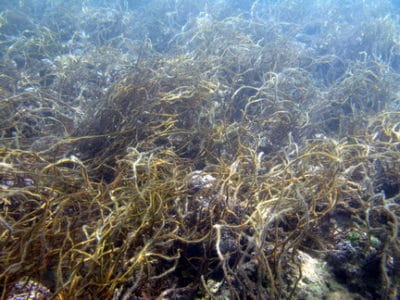
Shallow inshore reef flat with remains of Turbinaria fronds.
The shallow reef flat community on these inner reefs is much different as well. There are seasonal blooms of macroalgae, Turbinaria, which can be meters tall and tower over the bottom, shading everything underneath. Yet, corals seem to persist. Sure, many of these show signs of partial mortality, but in some places the shallow reef flat has a higher amount of coral than on the outer reef flat.
These reefs are also affected by temperature extremes. We measured temperatures of 32-34°C, while some of our outer spots were only 27°C with patches of even cooler water bathing the reef. It’s still early in the year, and temperatures will warm up everywhere, but these inner reefs will remain hotter than outside reefs. They are not surrounded by deepwater (500m plus) channels found offshore. Additionally, there is less flushing because they are protected from stiff currents and decreased wave exposure, all of which are factors that are thought to enhance resilience. There are some things that may help these inner reefs, though. Since it is murky, there is less penetration of harmful rays of the sun; ultraviolet radiation is much more of a concern to the clear water of the outer sites.
I mentioned that there are some differences in the coral community, as well. The dominant members of the community in inshore areas are the massive colonies of Porites, a taxa known to be resistant to many stressors. These form much of the framework of Red Sea reefs, but on many offshore sites they are not doing nearly as well as on inner sites. You can find large areas offshore that appeared to once have flourishing areas of columnar Porites colonies, especially in slightly deeper water (15-20m depth). They are simply a remnant of their former glory; small patches of living tissue, with much of their skeletal surfaces being colonized by other taxa, including non reef-builders like the soft corals. On inner sites, these were robust and very healthy on the shallow forereef and reef slope.

Large Porites colonies in a reef crest.
We also noted a near disappearance of one of the “weediest” corals, known as antler coral or Pocillopora. This coral is among the most abundant of the corals seen in outer sites and it just doesn’t seem to do well on the inner sites.
Another visually fascinating occurrence, something expected because of reduced light levels, is the modifications in growth form of many of the corals found on inner reefs. Everything seems to form large plates, even in shallow water. We found dense areas of Montipora with colonies forming large fronds several meters in diameter that resemble the petals of an oversized rose or hibiscus flower. Other plating growth forms were common, including colonies of Echinopora, Mycedium, Oxypora and Echinophyllia.
Many of these corals also had upright projections, which are branch-like structures that allow them to persist in areas with high sedimentation. The purpose of these projections is to prevent sediments from smothering the sensitive polyps when they are unable to accumulate, like on flat surfaces.
What’s also most remarkable is the high level of variability between sites. Within an individual reef platform, we find dramatic differences in living coral cover, often only a few hundred meters away. Some of this can be explained by wave exposure where we see dramatic differences between the leeward and windward side of the reef. Other environmental factors, such as the distance from land, the direction the reef faces, depth of surrounding water, amount of rugosity (relief), biological interactions and presence of intact functional groups (such as a balance between herbivores, omnivores and predators), among other things, will also be important in assessing resilience.
We’ve only just begun to understand these complex ecosystems, and will continue to remain intrigued by new discoveries. This information could lead to very specific interventions resource managers could take. For instance, fishing may need to be closed for various herbivorous fish groups during or after a bleaching event to minimize algal competition with recovering corals.
